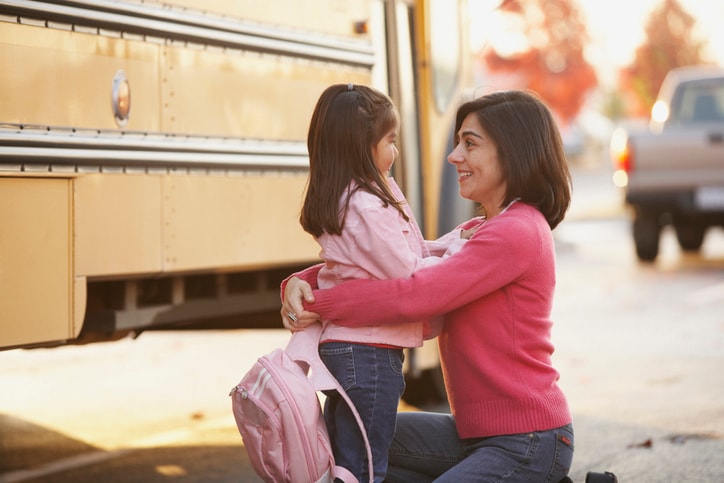The back-to-school season means shopping for new school supplies, checking to see if last year’s sneakers still fit and lining up after-school care. It’s also the right time to make sure you’re up-to-date on the latest news regarding COVID-19. The start of a new school year is typically the preamble to cold and flu season, and COVID is, unfortunately, still a threat on the viral radar. But, with a few precautions and attention to the latest recommendations, it’s possible to keep COVID infections at bay and keep missed class days to a minimum.
“As much as we don’t want to continue talking about it, COVID-19 is still among us,” says Dr. Christina Johns, a pediatric emergency physician and senior medical advisor at PM Pediatric Care. “We should still expect it to come and go, and we should still be ready to address it appropriately if our family is affected.”
Here’s a rundown of the latest official COVID guidance and what medical experts recommend to keep kids (and their families, teachers and caregivers) safe and healthy as we head into the new school year.
Is COVID still dangerous?
Here’s the good news: As we head into the 2023-2024 school year, COVID is no longer classified as an emergency. In May, the World Health Organization (WHO) declared an end to the COVID-19 international public health emergency. The U.S. also ended the federal public health emergency. Additionally, many COVID-era precautions, such as mask mandates, have been rolled back.
Despite these positive developments, experts stress that the end of COVID as a public health emergency is not the same thing as the end of the pandemic. During a media briefing in May, WHO Director Tedros Adhanom Ghebreyesus told reporters that COVID continues to claim thousands of lives each month, and “the risk remains of new variants emerging that cause new surges in cases and deaths.”
Vaccines and other public health measures have improved health outcomes for many people, but the long-term impacts of COVID are still under investigation. COVID is associated with ongoing neurological problems, joint and muscle pain, heart problems and even diabetes. According to the Mayo Clinic, research suggests that between one month and one year after having COVID-19, one in five people ages 18 to 64 has at least one medical condition that might be due to the virus.
Kids account for more than 15 million U.S. COVID diagnoses that have been made since the start of the pandemic, according to the American Academy of Pediatrics (AAP). While COVID is thought to be less severe in kids, a recent study published in the journal Pediatrics found that 1 in 5 kids has long COVID symptoms months after infection. Fortunately, experts say there are plenty of precautions parents can take to prevent COVID infections and keep children healthy throughout the upcoming school year.
What are the symptoms of COVID that parents should know?
Though new virus variants continue to circulate, Johns says the most common symptoms of COVID have remained mostly the same since the pandemic’s start. She advises parents to watch out for:
- Fever.
- Cough.
- Sore throat.
- Upset stomach.
- Headache.
- Loss of taste and/or smell.
There are other, more rare symptoms that may also show up. In some cases, the American Academy of Ophthalmology reports kids developing conjunctivitis, or pink eye, as a result of COVID-19 infection. The Mayo Clinic also lists unexplained skin rashes, as well as swelling or discoloration on the fingers and toes, as possible symptoms of the virus.
COVID symptoms may not look the same for every child, Johns says. It’s also possible that some kids with COVID won’t exhibit any symptoms at all. “There is a wide variety of symptom severity,” she explains. “Some children get intense symptoms, while others get mild ones or are asymptomatic.”
How can I tell if my child needs to stay home from school?
Keeping kids home when they’re sick is one major way to prevent the spread of infections at school. In general, pediatricians recommend keeping kids home from school or daycare whenever they have any of the following signs of illness:
- Fever above 100.4 degrees.
- Persistent cough and/or congestion.
- Rashes, blisters or lesions that are spreading.
- Stomach pain, nausea or vomiting.
- Sore throat.
- Headache.
- Loss of taste and/or smell.
Johns says kids who have symptoms of COVID should stay home from school and be tested for the virus. Those who test positive for COVID should stay home and away from others for at least five days from the onset of symptoms, according to the latest CDC recommendations.
“If there are symptoms present that are consistent with COVID-19 infection, staying home and away from others is the right thing to do.”
— Dr. Christina Johns, a pediatric emergency physician
How to test kids for COVID-19
If kids have symptoms of COVID or have been exposed to someone else who tested positive, parents and caregivers can administer either an at-home COVID antigen test or a polymerase chain reaction (PCR) test, which is available at many doctor’s offices and pharmacies.
If you use an at-home antigen test, be aware that the U.S. Food and Drug Administration (FDA) recommends testing more than once to prevent false negatives. The testing guidelines are as follows:
- If a COVID test is positive, the result is most likely accurate and isolation should begin.
- If a COVID test is negative but symptoms are present, a second test should be administered 48 hours after the first one.
- If a child has no symptoms but has been exposed to COVID, they should also be tested at least twice in a 48-hour period.
During the testing period, those with COVID symptoms should avoid contact with others to prevent transmission of the virus. “If there are symptoms present that are consistent with COVID-19 infection, staying home and away from others is the right thing to do,” Johns explains.
If you have any questions regarding COVID test results or whether it’s OK for your children to go to school, Johns recommends contacting your child’s pediatrician.
Does my child need a COVID booster shot?
COVID vaccines are an important step in preventing the worst symptoms and side effects of the virus, but the messaging around vaccination continues to be confusing. You might be wondering, does my child actually need a booster shot, and when is the best time to get vaccinated?
The most up-to-date COVID vaccination available is the monovalent XBB.1.5 booster shot that was authorized this fall. Currently, the CDC recommends that everyone 6 months and older who does not have contraindications should receive the updated shot.
If you have questions about the updated COVID vaccine or your child recently had a COVID infection, Johns says you can check with your child’s pediatrician about the best time to get them vaccinated.
Should my child wear a mask at school?
Mask mandates are no longer in place in many parts of the country, but that doesn’t mean masks are no longer useful. The CDC recommends wearing a well-fitted, high-quality face mask if:
- You live in an area with high rates of infection and hospitalization.
- You are at high-risk for getting very sick.
- You have a household or social contact who’s at high-risk for getting sick.
Masks are also recommended on public transportation, and the CDC advises that masks can be beneficial to anyone wanting extra protection in indoor public places. While most schools no longer require masks, Johns says they are a useful tool to help prevent virus transmission during peak sickness times, such as at the start of the school year or during cold and flu season. “Masks never hurt, and wearing one during higher risk infection times is a good way to lessen the risk,” Johns explains.
How can I prevent COVID during the school year?
In addition to making strategic use of masks to prevent COVID infections, parents can also offer kids a refresher on how to protect themselves from illness, Johns says.
Last year, rates of flu and Respiratory Syncytial Virus (RSV) spiked along with cases of COVID-19. Encouraging kids to take precautions and practice good hygiene can potentially help prevent a host of illnesses and missed class days. To help kids stay well, Johns advises:
- Checking community rates of infection in your area, if they’re available.
- Reviewing hand hygiene (the UK’s National Health Service even put out a kid-friendly handwashing song).
- Reminding kids not to share food or drinks with other people.
- Encouraging kids to give others their personal space.
“The key is to be flexible and adjust to each situation,” Johns says. She also recommends staying up-to-date on the latest guidance from the CDC and turning to your child’s pediatrician whenever you have questions.
COVID may continue to be a part of kids’ lives for many years to come, but with trusted guidance from experts and a few extra precautions, it’s possible to have a productive and healthy return to the classroom.






